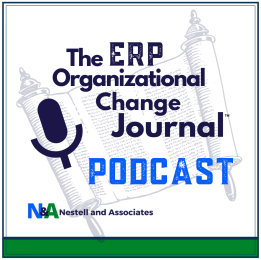Before selecting an ERP system, it’s essential to define your business needs and goals clearly.
Knowing how to choose an ERP system starts with analyzing your business. Before selecting an ERP system, it’s essential to define your business needs and goals clearly. This will guide you to an ERP system that is well-suited to your organization’s core processes and aligns with your business objectives. Once you have narrowed down your options, you are ready to begin ERP system selection.
Keep reading for tips and ERP selection process best practices from the ERP Consulting experts at Nestell & Associates.
Select an ERP System for All Users
To ensure that the selected ERP system meets the needs of the entire organization, the decision should not be made by a single individual or department. You must correctly identify stakeholders.
A stakeholder is any entity impacted by the ERP system, meaning end users working with the system daily will determine success or failure post-go-live as much as dedicated project managers, analysts and IT team members.
Although executing any successful ERP project plan requires strong leadership and administrative skills and professional delivery of IT services and support, today there is a greater emphasis on change management than technological change. Even the most suitable ERP solution for your organization will fail with a resistant or ill-equipped workforce.
Correctly identifying and involving key stakeholders during the ERP selection process will help create a strategic vision, facilitate employee buy-in and guide organizational learning.
Effective Stakeholder Engagement
To ensure the ERP system you choose aligns well with your organization’s needs, engaging stakeholders effectively is crucial. Here are several strategies to consider:
-
Regular Communication: Establish a routine of regular update meetings throughout the ERP selection process. This keeps all stakeholders informed and engaged, ensuring their needs and concerns are addressed.
-
Collaborative Tools: Utilize collaborative tools and technologies to enhance communication among stakeholders. Platforms like Microsoft Teams or Slack can facilitate smoother interaction and decision-making among diverse groups.
-
Feedback Mechanisms: Implement simple feedback mechanisms such as surveys or quick feedback sessions at key milestones. These allow stakeholders to voice their concerns and suggestions promptly, ensuring that their input is considered in the decision-making process.
-
Leadership Involvement: Leadership should actively promote and participate in stakeholder engagement efforts. Their involvement can help mitigate resistance and foster an environment of trust and transparency.
By integrating these strategies, you can improve stakeholder engagement and ensure the ERP system selected meets the varied needs of your organization.
Evaluate Vendors as Partners When Selecting an ERP System
There are many different ERP systems on the market, so it’s important to research and compare your options to find the one that best fits your needs. Consider factors such as functionality, scalability, integration with other systems and a vendor’s commitment to ongoing support and development of their product.
When selecting an ERP system, don’t just rely on a vendor’s sales pitch – conduct a thorough evaluation by doing your research and questioning claims that gloss over the challenges, risks and disruptions inherent to ERP organizational change. Start with asking how a vendor defines success and what percentage of their projects have been successful.
Success is not the prevention of challenges – it’s about being prepared to respond. Honesty and transparency in the sales cycle create respect and demonstrate a knowledgeable and reliable partner who will see your organization through digital transformation.
Strategic Evaluation Techniques:
-
Vendor History and Reputation: Research the vendor’s history in the industry, including their market presence, financial stability, and user reviews. This will provide insight into their long-term viability and commitment to their clients.
-
Customer References and Case Studies: Request and review detailed case studies and customer references. This will give you a clearer picture of how the vendor has supported other companies, particularly during challenging periods.
-
Post-Implementation Support: Clarify what type of support is offered after the ERP system goes live. This includes the availability of technical support, user training options, and how they handle updates and upgrades to the system.
-
Innovation and Roadmap: Assess the vendor’s commitment to innovation by reviewing their product roadmap. Understanding how they plan to evolve their ERP solutions can indicate whether they will continue to meet your future business needs.
Adding these strategic evaluation techniques can guide businesses to make more informed decisions and foster a partnership with an ERP vendor that not only meets their current requirements but also supports their long-term business strategy.

There are many costs to consider during ERP system selection.
Consider the Total Cost of Ownership
The initial costs of implementing an ERP system cover setup and configuration and may include customization, data migration, and training. As you budget for an ERP system, it’s crucial to consider the full spectrum of expenses that will affect your total cost of ownership. Reflect on the following questions and factors:
- License Fees: Are the fees based on the number of users, modules used, and the length of the license term clear and within your budget?
- Hardware & Infrastructure: Will you need to purchase new hardware or upgrade your existing infrastructure to support the ERP system? This can include servers, storage devices, and other hardware.
- Maintenance & Support: What are the expected costs for software updates and technical support? Are these services structured in a way that will support your long-term needs?
- Training: How often will ongoing training be required as new features are added or processes change? Have you accounted for the costs of keeping your staff trained and proficient?
- Data Conversion: If you are switching from a different ERP system or using legacy systems, have you considered the time and expenses involved in data conversion?
- Ongoing Costs: What are the anticipated ongoing operational costs, such as hosting fees or fees for additional users or modules?
Thinking through these questions can help you ensure a comprehensive understanding of the costs involved. This understanding is crucial not only for budgeting accurately but also for anticipating the strategic impact of the ERP system on your organization’s financial health.
Get Vendor-Neutral Help With the ERP Selection Process at Nestell & Associates
There are a multitude of ERP system-affiliated consultants, and while they may be able to demonstrate software capabilities and use their expertise to problem-solve within that system, they will always put the product before the customer. The value of objective ERP system selection cannot be overstated. Vendor-neutral ERP consultants are proven to increase the success of ERP organizational change.
Nestell & Associates is an independent ERP consultancy that can lead your organization through the ERP selection process using experience and research-based evidence of ERP success rather than anecdotes or alignment with a particular ERP system. Contact us today to make sure you select the right ERP solution for your business.
The ERP Organizational Change Journal – Podcast
We share smart ERP solutions and success stories, and promote organizational change and digital transformation success through industry trends and dedicated ERP professionals.
About Nestell & Associates
Where People, Processes, and Technology Align
Nestell & Associates specializes in providing M&A ERP and IT consulting services for private equity firms and their portfolio companies. We offer a range of vendor-neutral services to support all stages of the investment cycle.
Moreover, we know how to effectively minimize or eliminate the issues you experience during M&A. With Private Equity Technology Solutions as 100% of our business, we bring a unique approach to ERP that other firms can’t compete with.


